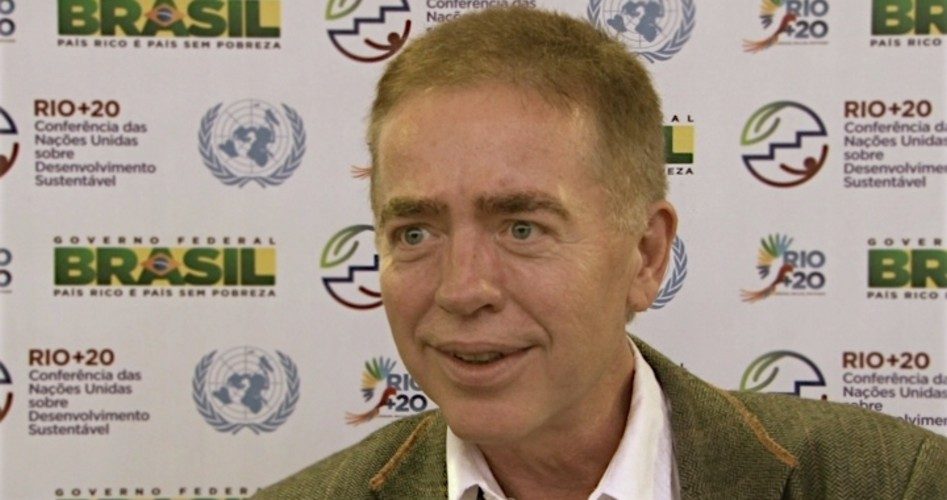
Some of the biggest “Green” environmental organizations in the world engage in blatant deception and propaganda to fill their coffers, leaving destruction and ruined lives in their wake, according to Icelandic investigative journalist Magnus Gudmundsson (pictured). In an exclusive interview with The New American at the United Nations Rio+20 Conference on Sustainable Development last month, he also wondered whether the latest UN “sustainability” craze was simply more of the same fraud.
In over 20 years of tracking non-governmental organizations’ (NGOs) environmental campaigns, Gudmundsson has documented a vast array of deliberate lies concocted by groups such as Greenpeace and other major players. He has also been one of the only journalists in the world to really cover the effects of the deception on the affected communities — especially in the Arctic.
“I started investigating the actions of Greenpeace and similar groups in the mid ’80s, and the more I investigated, the more disturbed I became, because what I found was quite disturbing,” Gudmundsson told TNA. The list of atrocities was long, too.
“The worst abuses I have seen by these groups are fabrications — falsifications — of animal torture,” he continued. “I have videos showing the ugliest animal torture you can imagine, perpetrated by environmental groups claiming that these are hunters, these are fisherman, these are bad guys. They are using those videos to promote their cause — mainly to collect money — in order to stop these bad guys from doing what they’re doing, which they’ve never done.”
At the UN Rio+20 summit, Gudmundsson offered a brief presentation on his findings during a press conference held with several other heavyweight critics of the conference. The horrific accounts of native communities destroyed by green propaganda included countless suicides and the virtual collapse of some once-thriving indigenous villages in the far North.
Among other evidence, the investigative journalist presented a staged film created by Greenpeace — marketed as a real video of a hunter — aimed at painting traditional Arctic seal hunters as brutal barbarians. The film was passed off as genuine to audiences around the world, and it yielded huge amounts of revenue for its creators. But analysts and specialists later confirmed that it was a complete fraud — staged for the camera.
The results of the environmental deception, however, have been very real. In one tiny island community off the coast of Alaska subjected to a vicious attack campaign by various “Green” and “animal rights” groups, for example, more than 100 people attempted to commit suicide in just one year, Gudmundsson said.
“The consequences have been destruction of local communities, native communities, all over the Northern hemisphere — communities in the South as well,” he explained in an exclusive on-camera interview. “It’s basically been economic and social devastation.”
And there were more than a few examples of the utter destruction wrought by bogus environmental campaigns on innocent native peoples. “I have been to villages where the graveyards are almost bigger than the village because of young suicide victims — young people who lost hope, lost their vision in life, because they were told by foreigners who came from the ‘big world’ that they were bad, that they were bad people and what their parents had been doing for centuries or thousands of years was bad,” Gudmundsson continued.
It is still going on, too. “It’s really sad. But I see the same trend again — here,” he said. “I see statements, I see propaganda, which is equally, sort of fabricated, or without substance, which will again affect smaller communities in particular,” he said. “So I am asking the question here: Is this legitimate? Are decisions made on facts, or are they made based on falsehood and fabrication?”
The “Green” groups, politicians, and even international entities still use the same tactics today, too, just focused on different issues, Gudmundsson explained. “The nature of these groups is that they need to expand constantly,” he said, noting that they all need money. “When one crisis has been ‘solved,’ as such, they have to find another one — if it’s not global warming, then now it’s sustainability.”
Gudmundsson was one of a small number of critics who attended the UN Rio+20 to try to blow the whistle on various problems. Other experts who asked hard questions and slammed the UN scheming included Lord Christopher Monckton, leaders with the Committee For A Constructive Tomorrow (CFACT), and a few more.
You can watch part of the interview with Gudmundsson below.
Related articles:
The Real Agenda Behind UN “Sustainability” Unmasked
UN Sustainability Summit Exposed: Big Business, Dictators, and NGOs
Despite Setbacks, UN “Sustainability” Agenda Marches on After Rio+20



